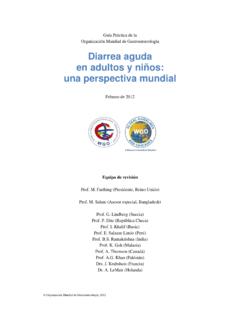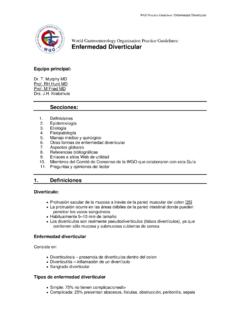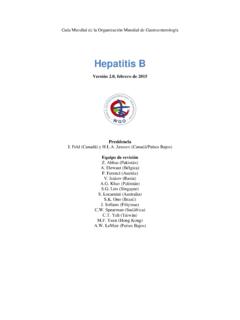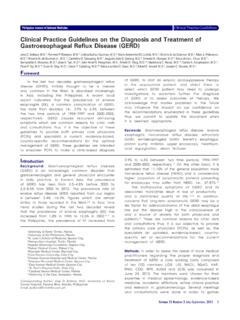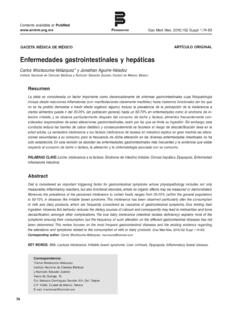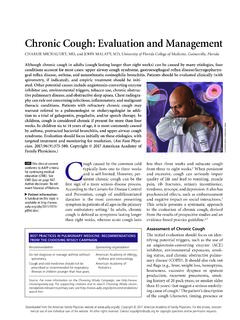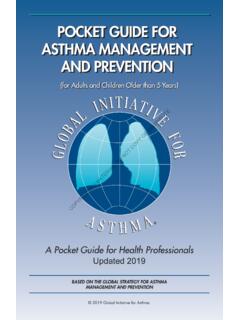Transcription of Map of Digestive Disorders April 2008
1 MAP OF Digestive Disorders & DISEASES Map of Digestive Disorders & Diseases (MDD) 2 ORIGINAL AUTHOR: Dr. Guarner Ms L zaro Ms Gasc n Ms Royo Dr. Eximan Dr. Herrero Map of Digestive Disorders & Diseases (MDD) 3 Index I. Map of Digestive Disorders and Diseases Definition Objectives Methodology II. gastroesophageal Reflux Disease (GERD) Main causes Complications and seriousness Diet and GERD GERD management Geographic prevalence of GERD III. Helicobacter pylori Infection Main causes Complications and seriousness Prevention Geographic prevalence IV. Colorectal Cancer Risk factors Diet and colorectal cancer prevention Geographic incidence of colorectal cancer V.
2 Functional Dyspepsia Main causes Complications and seriousness Diet and functional dyspepsia Geographic prevalence of functional dyspepsia Map of Digestive Disorders & Diseases (MDD) 4 VI. Functional Constipation Complications and seriousness Diet and functional constipation Geographic prevalence of constipation VII. Irritable Bowel Syndrome (IBS) Main causes Complications and seriousness Geographic prevalence of IBS VIII. Discussion Map of Digestive Disorders & Diseases (MDD) 5 I. Map of Digestive Disorders and Diseases Definition Digestive Disorders and diseases significantly affect millions of persons worldwide inducing a highly significant economical impact comprising health care costs and work absenteeism, in addition to patient s decreased quality of life.
3 Organic diseases reviewed in this document include gastroesophageal reflux disease, Helicobacter pylori infection, and colorectal cancer. Functional Digestive Disorders (the term functional means that there is no anatomical, structural or organic abnormality that explains the symptoms) reviewed include: functional dyspepsia, Irritable Bowel Syndrome (IBS), functional constipation. Objectives The aim of this document is to estimate the prevalence of Digestive Disorders and diseases on human health under a global worldwide perspective. The approach was not restricted to life-threatening diseases but also to functional Disorders , those conditions with potential impact on well-being and quality of life.
4 For this purpose, a group of experts proposed an initial list of gastroenterological Disorders or diseases to be investigated. Criteria for the selection of appropriate conditions were: first, their prevalence should be admittedly high, above 5% of the population in at least some parts of the World; second, data of candidate Disorders or diseases should be available in databases or medical literature in order to have the possibility of gathering a considerable number of data by a retrospective approach. After detailed screening, six worldwide prevalent Map of Digestive Disorders & Diseases (MDD) 6 Disorders or diseases were selected as shown in the table of contents of this document.
5 Methodology The first step was to establish definition and diagnostic criteria for each condition. On this issue, we adopted those concepts and criteria widely accepted in the medical literature, including Rome III criteria for functional Disorders , Montreal consensus on GERD, etc. Thereafter, the study has been developed by reference searches in medical databases together with data compiled by a questionnaire-based survey with the collaboration of the National Societies of Gastroenterology that are members of the World Gastroenterology Organization.
6 The final set of data was therefore composed by both statistical data published in scientific articles and information received directly from the National Societies. The main output consists in Tables of data as obtained from the above mentioned sources, showing national prevalence (incidence for colo-rectal cancer). Map of Digestive Disorders & Diseases (MDD) 7 II. gastroesophageal reflux disease (GERD) gastroesophageal reflux disease develops when the reflux of stomach contents in the esophagus causes chronic symptoms (such as heartburn, regurgitation, occasionally sore throat and cough) and mucosal damage (1).
7 GERD can be divided into: erosive GERD (presence of esophageal mucosal breaks at endoscopy) and non-erosive GERD (no lesions can be seen in the mucosa of the esophagus). The manifestations of GERD are divided into esophageal and extra esophageal symptoms. The main esophageal symptoms are heartburn and regurgitation. Heartburn is defined as a burning sensation in the retrosternal area, and regurgitation as the perception of flow of acidic material into the mouth or hypo pharynx. Extra esophageal symptoms include sore throat, cough, dysphagia and sleep disturbance.
8 Other processes denominated as atypical manifestations, or extra esophageal manifestations have been classified basically in three groups: breathing manifestations, thoracic atypical pain and manifestations of the oto-rhino-laryngea area and of the oral cavity. GERD may be present with no symptoms of heartburn; thus, people with dry cough, asthma or swallowing difficulties might suffer from this Digestive disease. Patients fulfill the diagnostic criteria of GERD when presenting one of the following characteristic symptoms: (i) troublesome heartburn and/or regurgitation more than twice a week, (ii) erosions of the esophagus near the junction with the stomach confirmed by upper gut endoscopy, (iii) abnormal values of 24-hour esophageal pH monitoring.
9 Map of Digestive Disorders & Diseases (MDD) 8 Nowadays GERD is considered a chronic entity that must be treated correctly. This is important considering that permanent acid reflux can induce esophageal complications such as esophagitis ( inflammation of the esophageal mucosa), hemorrhage, Barrett s esophagus, and adenocarcinoma in the esophagus. Main causes The pathophysiology of GERD is multifactorial and includes failure of the antireflux barrier (The lower esophageal sphincter responsible for allowing the transit of food and liquids to the stomach relaxes a few times a day in non-GERD individuals and more frequently in GERD patients), impaired esophageal clearance mechanisms, the presence of offensive factors in the refluxate, and defective esophageal tissue resistance (2).
10 Other factors correlated with GERD include pregnancy, smoking, and high body mass index (BMI). Complications and seriousness Analysis of GERD patients has revealed that nearly one third of patients had extra-esophageal symptoms and presented asthma, cough, and laryngitis (3). Additionally, GERD has been related to the development of Barrett s Esophagus, and also, although not commonly, adenocarcinoma of the esophagus (4). Barrett's esophagus is defined as the presence of intestinal metaplasia in the esophagus distal mucosa. The prevalence is about 10-15% amongst the patients with GERD.





